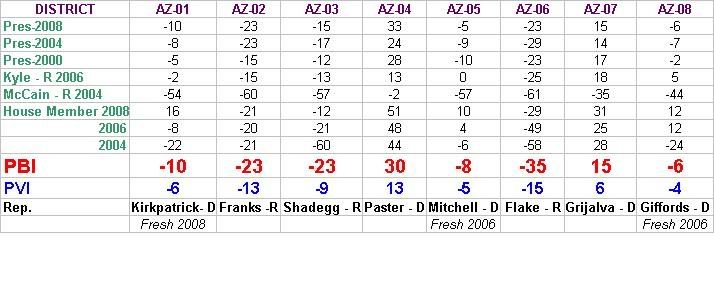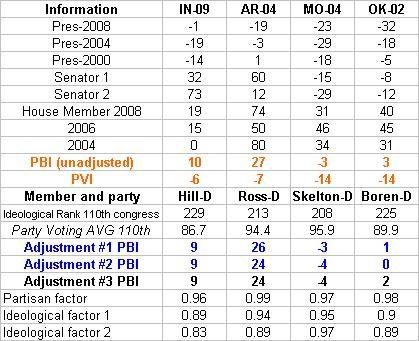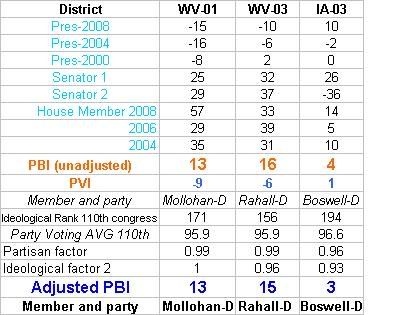• FL-Sen: There’s probably no good way to spin the firing of the head spinner: after weeks of unending bad press, Charlie Crist has decided the solution is to fire his long-time communication director, Erin Isaac. (Isaac contends that she left on her own, and the timing has nothing to do with Crist’s collapse.)
• IL-Sen, OH-Sen: Two little-known, never-been-elected rich guys are going on the air with TV spots in their respective Senate primaries: Democratic attorney Jacob Meister in Illinois, and Republican auto dealer Tom Ganley in Ohio. Meister may not have much hope in a field with three prominent candidates, but Ganley is trying to gain traction among the anti-establishment right against consummate insider pick Rob Portman in a two-way GOP primary fight. (Ganley’s buy is reportedly only for $60K, so it seems more oriented toward generating media buzz than actually reaching lots of eyeballs, though.)
• NC-Sen: Rep. Bob Etheridge still sounds genuinely undecided about whether to get into the Senate race or not, but he’s now promising a decision by the end of the week. The DSCC is actively courting Etheridge, despite the presence of SoS Elaine Marshall in the race. Meanwhile, two other possible contenders are circling, watching, and waiting: former Lt. Gov. Dennis Wicker says he may run if Etheridge doesn’t, and outgoing Chapel Hill mayor Kevin Foy is still considering the race, saying he’ll decide by the end of the month.
• SC-Sen: Ouch! Lindsey Graham just got a pretty strong repudiation from the local GOP in one of the state’s largest counties, Charleston County. They unanimously voted to censure Graham over his cooperation with Democrats and moderate GOPers. Graham isn’t up until 2014, but it certainly doesn’t bode well for his next primary.
• CO-Gov: Josh Penry’s jump out of the Colorado governor’s GOP primary may have been more of a push. Big-time GOP funder Phil Anschutz is reported to have personally contacted Penry to let him know that he’d be on the receiving end of the 501(c)(4) that he’d created to target anyone opposing establishment candidate ex-Rep. Scott McInnis. (Of course, with news of this having leaked out, that seems likely to just further enrage the teabaggy right and lead them to find a hard-right replacement who, unlike Penry, isn’t worried about having his brand besmirched for future runs. Could Tom Tancredo be that man?)
• CT-Gov: For about the zillionth time in his career, Democratic AG Richard Blumenthal decided not to run for a promotion; he says he won’t get involved in the newly-minted open seat gubernatorial race. However, Blumenthal did nothing to quash rumors that he’s waiting to take on Joe Lieberman in 2012, saying “stay tuned.” Meanwhile, Paulist financial guru Peter Schiff, currently running for the GOP Senate nod, confirmed that he won’t be leaping over to the gubernatorial race, either.
• SC-Gov: Fervently anti-tax state Rep. Nikki Haley has been a key Mark Sanford ally in the legislature, but she’s been lagging in the GOP gubernatorial primary race. A Mark Sanford endorsement would be poison at this point, though, so the Sanfords paid her back with a slightly-less-poisonous endorsement from Jenny Sanford instead. Still doesn’t really sound like the kind of endorsement you want to tout, though.
• FL-08: Republican leaders are increasingly sour on the candidacy of 28 year-old businessman Armando Gutierrez Jr., who is “pissing people off a lot” with his bare-knuckle style. The NRCC is still hoping to recruit a solid challenger to go up against “colorful” Dem Rep. Alan Grayson after months of recruitment mishaps, and the current batch of names being bandied about include businessman Bruce O’Donoghue, state Rep. Eric Eisnaugle, and state Rep. Kurt Kelly. Gutierrez, however, seems to be doing all he can to make the GOP primary an unpleasant proposition. (J)
• FL-19: The Democratic primary in the upcoming special election to replace Robert Wexler is shaping up to be a real snoozefest. Former State Rep. Irving Slosberg, who lost a bitter 2006 state Senate primary to Ted Deutsch, announced yesterday that he won’t be running and that he’s endorsing Deutch. (Slosberg probably has his eye on Deutch’s soon-to-be-vacant Senate seat.)
• ID-01: With state Rep. Ken Robert’s dropout in the 1st, Vaughn Ward had the GOP field to himself for only a couple hours before another state Rep., Raul Labrador, said that he’ll get in instead. Meanwhile, ex-Rep. Bill Sali has been speaking before conservative groups and is still considering an attempt at a rematch with Democratic Rep. Walt Minnick, and says he’ll decide by the end of the month.
• NJ-03: Democratic freshman Rep. John Adler has been seemingly running scared despite the Republicans not having recruited anyone in this swingy R+1 district, probably helped along by Chris Christie’s huge numbers last week in Ocean County. Republicans think they have the right guy to flatten Adler: former Philadelphia Eagles lineman Jon Runyan. Runyan isn’t retired but not on any team’s roster either, and is “considering” the race.
• NY-24: He lost narrowly in 2008 to Democratic Rep. Mike Arcuri, and now businessman Richard Hanna is making candidate-type noises again, with a press release attacking Arcuri’s health care reform vote. Hanna is thinking about another run; Republicans don’t seem to have any other strong candidates on tap in this R+2 district.
• SD-AL: Republican State Rep. Shantel Krebs decided against a run against Rep. Stephanie Herseth Sandlin in 2010. She was facing a cluttered field, with Secretary of State Chris Nelson and state Rep. Blake Curd already in the GOP primary.
• Nassau Co. Exec: So I was wrong about the Seattle mayor’s race being the last one to be called: the Nassau County Executive race is now in mid-recount, and Republican challenger Ed Mangano has a paper-thin (24 votes) lead over Democratic incumbent Tom Suozzi. Democratic Nassau County Legislator Dave Meijas (who you might remember from NY-03 in 2006) is also in a recount.
• VA-St. House: The last House of Delegates race in Virginia was finally called; Republican Ron Villaneuva was certified the victor in the Virginia Beach-based 21st over incumbent Dem Bobby Mathieson by a 13-vote margin, although the race is likely to go to a recount by Mathieson’s request.
• WA-St. Sen.: Democratic State Sen. Fred Jarrett was picked by new King Co. Executive Dow Constantine (who defeated Jarrett in the primary) to be the Deputy Executive. Jarrett will need to resign from the Senate to do so, creating a vacancy in this Bellevue-based, historically Republican but recently very Democratic seat. In Washington, though, legislative vacancies are filled by appointment by the county council (Democratic-controlled in King County, as you might expect), so there won’t be a special election, and the appointee will serve until (his or her probable re-election in) Nov. 2010.
• Generic Ballot: Everyone in the punditsphere seems abuzz today that Gallup suddenly shows a 4-pt GOP edge in the generic House ballot, a big swing from the previous D+2 edge. (Most other pollsters show a mid-single-digits Dem edge, like Pew at D+5 today.) Real Clear Politics points out an important caveat: the last time the GOP led the Gallup House ballot was September 2008, and you all remember how that election played out. Another poll today is perhaps more interesting: Winthrop University polled just the Old South states, and finds a 47-42 edge for the Republicans in the generic House ballot in the south. Initially that may not seem good, but remember that most of the state’s reddest districts are contained in the south, so, after accounting for the heavily-concentrated wingnuts, this probably extrapolates out to a Dem edge still present in southern swing districts.
• Public option: With the prospect of an opt-out public option looming large, the topic of whether to opt out is poised to become a hot issue in gubernatorial races in red states next year. Several states already have opt-out legislation proposed, although it remains to be seen whether any would actually go through with it (when considering how many states turned down stimulus funds in the end despite gubernatorial grandstanding… or how many states have decided to opt out of Medicaid, as they’re able to do).
• WATN?: Congratulations to Charlie Brown, who has accepted a position in the Dept. of Homeland Security. Unfortunately, this means Brown won’t be back for another kick at the football in CA-04.


